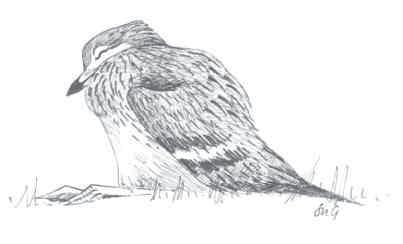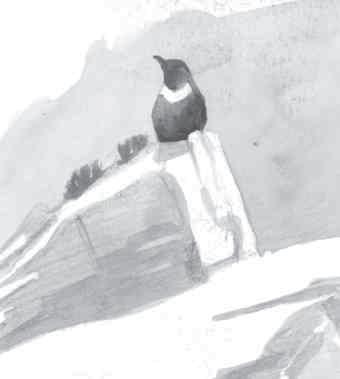
8 minute read
Looking back ...........................................................................Philip Murphy
For example, in France a Bee-eater doesn ’t eat bees; it is a “Guêpier ” – a wasper. And a Honeybuzzard doesn ’t eat honey; it too eats wasps, in Dutch, German, Danish, Norwegian, Hungarian and Russian; but in French, Spanish, Italian, Swedish, Icelandic, Finnish, Czech and Greek it eats bees.
With gulls it is even worse, because the translated English name often refers to a completely different species. The Mediterranean Gull in most European languages is the Blackheaded Gull: Mouette mélanocéphale; Zvartkopmeeuw; Schwarzkopfmöwe; Gaviota cabacinegra, Svarthuvad mås – as is the scientific name Larus melanocephalus. But the Black-headed Gull in French is the Laughing Gull – Mouette rieuse – as it is in German – Lachmöwe. Moreover a German Heringsmöwe is not a Herring Gull, but a Lesser Black-backed Gull. For Herring Gull think silver: Goéland argenté, Silbermöwe, Zilvermeeuw, Gaviota argentea. “Gull” , incidentally, is the only English bird-name that has entered modern English from the old Cornish Gaelic language, displacing the Anglo-Saxon (and common Germanic) “ mew ”2 sometime in the Middle Ages, which survives now only as an element of “Fulmar ” – the foul mew, so-called from its charming habit of regurgitating the contents of its stomach at anything that disturbs it on the nest.
1 Though it does appear recently to be returning to this region, albeit slowly.
2 Proof-reader observation: This dialect variation is still preserved in the US species name Mew Gull (Larus canus, i.e. what we call the Common Gull).
Philip Murphy
Looking back
– April to June 1962 and 1987
Selected highlights from the 1962 and 1987 Suffolk Bird reports for the period April to June.
50years ago The 1962 breeding season produced some fascinating observations. Minsmere, perhaps not surprisingly, hosted several notable species; particularly noteworthy were the county ’ s only breeding Marsh Harriers with three nests producing up to ten young, one, possibly two, pairs of Garganey, a pair of Stone Curlews which failed to breed because of disturbance by birdwatchers, two pairs of Common Terns which bred on an artificial island on the Scrape (the first recorded instance of such behaviour at Minsmere), and a pair of Montagu ’ s Harriers on site, 10th to 22nd June which raised expectations but failed to breed, and as many as 35 Cuckoos, 30th May.
Havergate specialities Elsewhere, Havergate remained the sole British breeding site for Avocets with 77 pairs, although only 25 young fledged; the island also hosted as many as 800 pairs of Sandwich Terns, the highest total since the species first colonised the site in 1951. Up to four Stone Curlews were in the Havergate/Orfordness area from late April to June, but with no proven breeding. Havergate was also Suffolk’ s only site to host breeding Short-eared Owls with three pairs being located.
It was the fifth consecutive year that Kittiwakes had bred on the South Pier Pavilion at Lowestoft. However, inclement weather in the summer of 1962 and “the inadequacy ofthe nesting-ledge ” resulted in only three juveniles being fledged.
An early Red-backed Shrike was at Minsmere, 1st May – an overall total of 35 pairs were located at four coastal sites, with 12 – 20 pairs “known on Breck” .
Coypu problem The presence of Coypu in our coastal reedbeds was having a detrimental effect on at least two species; we read of Little Grebe that “breeding numbers at Minsmere were down from 12pairs
to three, probably due to destruction ofnests by Coypu
” . Further up the coast at Walberswick, the Marsh Harrier was described as being a recently lost breeding species “ presumably as a result of the coypu invasion ” .
How times change! Also on the breeding scene we read of the Collared Dove that it “ continues to spreadand increase along the coast but there is very little evidence that it is spreading inland” . As a result of dry, cold and sunless conditions during May and June, breeding results of most insectivorous species were very poor –“ many observers reportedbroods ofthrushes andblackbirds, tits, robins, wrens, swallows, hedge-sparrows and larks being founddeadin the nest apparently from lackoffood” .
Laggard winter birds at Minsmere included Whooper Swan, 4th April, Bewick’ s Swan, 8th April, Rough-legged Buzzard, 22nd April and Hen Harrier, 19th May. What was possibly the same Hooded Crow was noted on 2nd June at Havergate and 10th June at Minsmere where it remained until 4th July “ when birdwas shot by keeper ” .
Lord Tollemache recorded a Hoopoe at Helmingham “for a few days in April” , and another was on Orfordness in early June. A Wryneck at Minsmere, 22nd April was, remarkably, the year ’ s only record – just six years before, in 1956, up to ten pairs had bred in Suffolk. A male Red-spotted Bluethroat was seen and heard singing in an Aldeburgh garden, 5th May. The period’ s only national rarity was a Caspian Tern on 6th June at Minsmere, the second site record following one there in July 1961. As many as five Roseate Terns were at Minsmere, 21st and 24th June.
Spring wader passage was mediocre. The most unexpected sighting was of about 120 Bar-tailed Godwits heading ENE over Risby, Bury St.Edmunds, 29th April on which date 116 (the same birds?) were on Breydon Water. Single Kentish Plovers were on Havergate, 22nd April and 1st June, and up to two at Walberswick, 26th to 28th April. Whimbrel passage peaked on 14th May when 100 were on Havergate, where also up to four Little Stints were present, 14th to 28th May. The year ’ s only Temminck’ s Stint was seen at Minsmere, 9th and 10th May. As many as six Wood Sandpipers at Walberswick, 26th June were probably early autumn birds.
Sea-watchers at Minsmere, 7th April, must have been somewhat surprised to observe a Bittern flying north at least a kilometre offshore.
A strong southerly passage of Linnets is a feature of spring in Suffolk; in 1962 it peaked spectacularly on 20th April when it was estimated that at least 12,000, still the county ’ s record day-total, flew south over Minsmere.
But some things don’t change Some aspects of ornithology have not changed in 50 years; single Red-headed Buntings were at Lakenheath, 13th April and Walberswick, 29th May but we read that “Allexamples ofthis species are ofcourse suspect aspossible ‘ escapes ’” – this situation remains unchanged half a century later.
25years ago Birding in Suffolk stepped up a gear in 1987 with increased effort, particularly at Landguard and the county ’ s principal seawatching sites, resulting in a wealth of outstanding observations. In his editorial, Steve Piotrowski wrote, “ ornithologists were treatedto a spectacular avian display, whichalmost spannedtheyear.
A long-overdue addition to the Suffolk list occurred during this period when a Red-rumped Swallow was found perched on telephone wires at the Eel’ s Foot Inn, Eastbridge on 21st April –four more were to be located in late autumn. Additional outstanding sightings in April included Alpine Swift, Minsmere, 18th (at the time, the earliest-ever in Suffolk), Bluethroats on 5th at Minsmere (male White-spotted) and Havergate, Suffolk’ s earliest-ever Golden Oriole, Badley, 19th and two male Ortolan Buntings, Lowestoft, 30th April to 9th May.
May ’ s principal reports were of a Broad-billed Sandpiper, Walberswick, 29th to 1st June, and a Caspian Tern, 8th to 11th at Minsmere, while in June birders were treated to a third-year Night Heron, Holbrook, 14th to 21st, Gull-billed Tern
north off Benacre, 24th and a Bee-eater over Covehithe Cliffs, 14th.
Warblers were the star attraction at Landguard in late spring with Suffolk’ s second record of Marsh Warbler, 9th and 10th June, second Subalpine Warbler, 8th to 10th June and second spring record of Barred Warbler, 30th May to 1st June –Suffolk’ s first spring record of Barred Warbler occurred at Minsmere on 22nd May 1960.
Winter laggards There were several unexpected sightings of species more typically associated with the winter months. These included Bewick’ s Swan, Benacre, 2nd to 11th May, “ redhead“ Smew, Flatford, to 28th May, Purple Sandpiper, Landguard, 5th June, Rough-legged Buzzard, Ashby/Fritton, 22nd to 26th June and, perhaps most remarkably, a Shore Lark at Lowestoft, 4th June – not surprisingly, this remains as Suffolk’ s sole June record of Shore Lark. In addition, a Fieldfare was trapped at Sizewell, 28th June and single Redwings were at Minsmere, 13th June and “ an inlandsite ” (singing male), 14th June.
It was also an excellent breeding season. Fulmars increased to ten pairs at Bawdsey Cliffs, although only five young were reared, but the Bittern population declined further to only ten “boomers ” . A pair of Pintail almost certainly bred at one site and 35 Marsh Harrier juveniles fledged from 13 nests. Two pairs of Goshawks bred – one nest was robbed by falconers/eggcollectors but three young were reared from the second nest.
It was the best year for Quail since 1964 with reports of 35 calling birds and at least six singing Spotted Crakes were located.
Waders Breeding waders included four pairs of Oystercatchers in the Breck, the first-ever breeding records in west Suffolk. There were 50 pairs of Stone Curlews in the Breck but only one on the coast, 25 pairs of Little Ringed Plovers at nine sites, an overall total of 40 “ roding ” Woodcock, “lekking ” Ruff at one site and up to five pairs of Black-tailed Godwits on the coast. Up to 20 pairs of Common Snipe were recorded and
Stone Curlew numbers up, yet “only one on the coast”
we read that “ifthis is anything like a true assessment there is serious cause for concern.
Gulls and terns also had an excellent season with as many as 350 pairs of Little Terns that reared at least 162 young (133 pairs and 15 young in 2010), 200 pairs of Sandwich Terns on Havergate (none in 2010) and a record total, at the time, of 142 juvenile Kittiwakes reared at Lowestoft.
Chats and redstarts are struggling in the 21st century but fared well in 1987. Impressive totals of breeding pairs included 15 Black Redstarts, 43 Common Redstarts, 20 Whinchats (two on coast) and 18 Wheatears (six on coast). The first-ever instance of over-summering by Ring Ouzels in Suffolk involved one at Minsmere from 18th June onwards into the autumn – a second bird joined it on 19th June, but there was no evidence of a nesting attempt.









